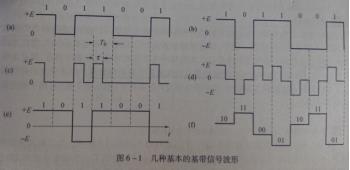A digital baseband signal is an electrical waveform that represents digital information, which can be represented by different levels or pulses. There are many types of digital baseband signals (hereinafter referred to as baseband signals). Figure 6-1 shows a few basic baseband signal waveforms, and we’ll use the rectangular pulse as an example.
1. Unipolar waveform
As shown in Figure 6-1(a), this is the simplest baseband signal waveform. It uses a positive level and a zero level to represent the binary numbers “1″ and “0,” or it uses the presence or absence of pulses to represent “1″ and “0″ in a symbol time.The characteristics of this waveform are that there is no interval between electrical pulses, the polarity is single, and it is easily generated by TTL and CMOS circuits. It can be sent inside a computer or between very close objects, like a printed circuit board and a chassis.
2. Bipolar waveform
It uses positive and negative level pulses to represent the binary digits “1″ and “0,” as shown in Figure 6-1(b).Because the positive and negative levels have equal amplitudes and opposite polarities, there is no DC component when the probability of “1″ and “0″ appears, which is conducive to transmission in the channel, and the decision level for restoring the signal at the receiving end is zero, Therefore, it is not affected by the change of channel characteristics, and the anti-interference ability is also strong. ITU-T’s V.24 interface standard and the American Electrotechnical Association’s (EIA) RS-232C interface standard both use bipolar waveforms.
3. Unipolar return-to-zero waveform
The active pulse width of the return-to-zero (RZ) waveform is less than the symbol width T, which means that the signal voltage always returns to zero before the termination time of a symbol, as shown in Figure 6-1(c).show. Usually, the return-to-zero waveform uses a half-duty code, that is, the duty cycle (T/TB) is 50%, and the timing information can be directly extracted from the unipolar RZ waveform. transition waveform.
corresponding to the return-to-zero waveform. The unipolar and bipolar waveforms above belong to non-return-to-zero (NRZ) waveforms with a duty cycle of.
4.Bipolar return-to-zero waveform
It is the return-to-zero form of the bipolar waveform, as shown in Figure 6-1(d). It combines the characteristics of bipolar and return-to-zero waveforms. Because there is a zero potential interval between adjacent pulses, the receiver can easily identify the start and end moments of each symbol, so that the sender and receiver can maintain correct bit synchronization. This advantage makes bipolar nulling waveforms useful.
5. Differential waveform
This kind of waveform expresses the message with the transition and change of the level of the adjacent symbol, regardless of the potential or polarity of the symbol itself, as shown in Figure 6-1(e). In the figure, “1″ is represented by level jumping, and “0″ is represented by level unchanged. Of course, the above provisions can also be reversed. Since the differential waveform represents the message by the relative change of the adjacent pulse levels, it is also called the relative code waveform and correspondingly, the preceding unipolar or bipolar waveform is called the absolute code waveform. Using differential waveforms to transmit messages can eliminate the effect of the initial state of the device, especially in phase modulation systems. It can be used to solve the problem of carrier phase ambiguity.
6. Multi-level waveform
There are only two levels of the above waveforms, that is, one binary symbol corresponds to one pulse. In order to improve the frequency band utilization, a multi-level waveform or multi-value waveform can be used. Figure 6-1(f) depicts a four-level waveform 2B1Q (two bits are represented by one of the four levels), where 11 represents +3E, 10 represents +E, 00 represents -E, and 01 represents -3E.The multi-level waveform is used in high-speed data transmission systems with limited frequency bands. Since one pulse of a multi-level waveform corresponds to multiple binary codes, the bit rate is increased under the condition of the same baud rate (same transmission bandwidth). It has been widely used.
It should be noted that the waveform of a single pulse representing an information symbol is not necessarily rectangular. According to actual needs and channel conditions, other forms such as Gaussian pulse, raised cosine pulse, etc. can also be used. But no matter what form of the waveform is used, a digital baseband signal can be represented mathematically. If the waveforms representing the symbols are the same but the level values are different.
This is the “Introduction to Digital Baseband Signal Waveforms” brought to you by Shenzhen HDV Phoelectron Technology Co., Ltd., I hope this article can help you to increase your knowledge. Besides this article if you’re looking for a good optical fiber communication equipment manufacturer company you may consider about us.
Shenzhen HDV photoelectric Technology Co., Ltd. is mainly a manufacturer of communication products. At present, the equipment produced covers the ONU series, optical module series, OLT series, and transceiver series. We can provide customized services for different scenarios. You are welcome to consult.







